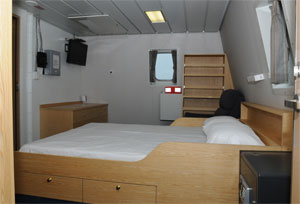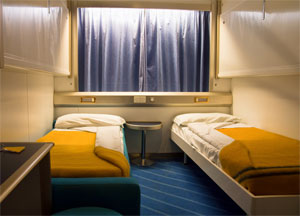In the Gulf of Mexico, new offshore supply vessels (OSVs) are more comfortable now as companies try to retain mariners in a tight labor market while rigs expand in number and move farther out.
As stays on OSVs get longer — sometimes 28 days on and 28 days off — vessel owners are making quarters as livable as possible, said Patrick Granger, president and chief executive of PVG Global LLC. His firm outfits OSVs in Broussard, La.
“Staterooms now have bathrooms en suite,” he said. “Wi-Fi, satellite TV and electronic games are installed.” Dining areas are attractive and color-coordinated, with amenities including self-service ice cream machines.
Because of heightened federal safety regulations in recent years, new interiors include more non-combustibles, mainly metal, and less wood, Granger said. Kitchens on the latest vessels are stainless steel.
“As mariners stay out longer, living quarters are more like the inside of a home and include leisure activities,” said Allen Powell, vice president at Boca Raton, Fla.-based Jamestown Metal Marine, which installs accommodations. Europe was the leader in an emphasis on comfort 25 years ago, he said. “Their vessel culture is different from the United States,” he noted. European mariners sometimes bring their families along.
As vessel owners order amenities, including entertainment systems and theaters, they’re paying more for interior decorating.
 |
|
Roomy staterooms aboard modern offshore supply vessels provided by Jamestown Metal Marine, above, and PVG Global, below. |
 |
In Covington, La., Hornbeck Offshore has focused on improving habitability since its first vessel designs were introduced in 1998, Carl Annessa, executive vice president and chief operating officer, said last month. “As vessels have grown in size, our own designs and those of other companies have moved from providing en suite heads to including workout rooms, theaters, offices and conference rooms,” he said. “These changes have improved the experience of our sailors and the charterer representatives that embark on our vessels.”
Living quarters are less crowded now. “The days of the bunk-room approach, where four to six sailors share a berthing space, with a common head somewhere on the deck remote from that space, are fading quickly,” Annessa said. Hornbeck prefers to keep staterooms sleeping more than two to a minimum, though that isn’t always possible, Annessa said.
The company is in the midst of an aggressive OSV new-build program. Hornbeck’s HOSMax 300 series diesel-electric powered OSVs contain 17 air-conditioned and heated staterooms, certified for berthing 50 people. HOS Renaissance, the third HOSMax 300 in a series of four, was launched in June. Six HOSMax 310 OSVs under contract are designed to include 17 staterooms for 50 crew. The company’s HOSMax 320 design has 13 staterooms for 24 people.
Hornbeck owns a fleet of 77 vessels, mainly serving the energy industry, and has nearly two dozen high-spec, upstream vessels planned or under construction for delivery through 2016.
Hornbeck has worked on its heating, ventilation and air conditioning systems and its lighting to improve the crew’s experience, Annessa said. “A lot of attention has been given to general noise reduction and in particular to noise avoidance,” he said. “Most berthing spaces on the newer designs are located at least one deck removed from noise sources.”
Attention to the importance of sleep and vessel safety has grown in recent years. Under the 2010 Manila Amendments to the Standards of Training, Certification and Watchkeeping, mariners must be allowed at least 10 hours of rest in a 24-hour span and 77 hours over seven days.
Hornbeck has upgraded the daily life of its crews with satellite communications that are always active. “Connectivity with loved ones at home is much better than in the past,” Annessa said. “We include en suite satellite TV connections in our new boats.”
A desire to retain crew has helped drive habitability, Annessa said. “Sailors who pioneered this industry would be very surprised at how vastly improved today’s live-aboard experience is,” he said.

